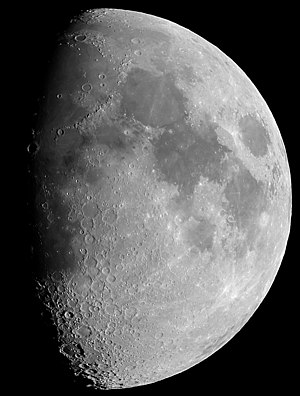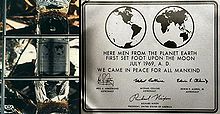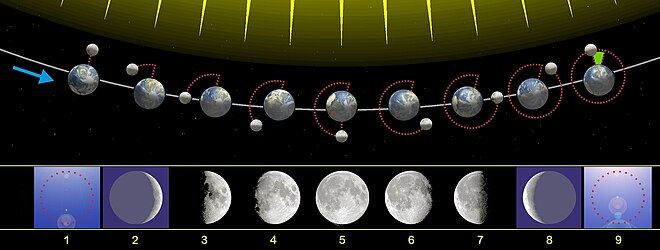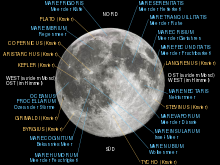
The moon is lying in space, in a stable orbit around the earth.
It is not a conventional travel destination, but has been included in the Apollo missions of American Astronauts traveled.
In the 1950s / 1960s there was a space race between the two great powers USA and USSR instead of. While the Soviet Union was the first to send satellites into space and to the moon, the first living being (the dog Laika) and the first humans (Yuri Gagarin) into space, the Americans won the race to the moon: Neil Armstrong was the first person to walk on the moon on July 21, 1969. Left with Apollo 17 Eugene Cernan in December 1972 as the twelfth and so far last person to return to the satellite. After that there was a break in the entire moon space trip.
Research programs have increased again in recent years. One started in 1990 japanese Experimental probe. NASA spacecraft, the ESA and the People's Republic of China followed. Currently there are unmanned missions to the moon from Russia and India planned, China has its first unmanned moon landing in December 2013 "Chang’e-3" carried out, the exposed moon rover "Yutu" should be in operation on the lunar surface for three months, a return mission for lunar rocks is planned for 2017. There is also with the Google Lunar X-Prize (US $ 30 million) has been a competition since 2007 which, similar to the Ansari X-Prize, is intended to promote private space flight activities, but so far it has only been advertised for unmanned flights.
Regions

The surface of the moon is 38 million square kilometers, which is between the size of Africa (30 million km²) and that of Asia (44 million km²). The top layer is several meters thick Regolith, a dry, gray dust. It is created by the constant, unchecked impact meteoroids that pulverize the lunar rocks. The greatest difference in altitude on the moon is 16 kilometers, the highest point is on the back.
Various structures on the surface can sometimes be recognized from the earth without any tools.
Lunar seas
A Mare (Latin for "moon sea") is a dark, very large plain of the moon. On the side facing the earth they occur more frequently (31% of the surface), but very rarely on the back (only 2%). The most noticeable structure is in the northern half and is popularly called the "man in the moon" (or "moon face").
In addition to the Maria (Latin for "seas") there are also corresponding names for smaller levels and attached structures: Oceanus ("ocean"), Lacus ("lake"), Palus ("swamp") and Sinus ("bay"). There is a list of important levels in the Wikipedia.
Continents
A Terrae is a highland on the moon. Presumably this is the original lunar crust. Several mountains reach heights of 10 km, they are mostly named after mountains on earth, see the Wikipedia list. Through the mountains pull themselves in some places Valleys (Called Vallis). They are a few hundred kilometers long and often only a few kilometers wide, their depth is a few hundred meters. They are mostly named after nearby craters, see Wikipedia list.
crater
The crater almost all of them on the moon were formed several billion years ago by impacts by asteroids. They reach sizes of up to 2240 km (South Pole Aitken Basin, up to 12 km deep) and are very numerous, over 40,000 craters are counted on the front alone - there are many more on the rear. They are named after astronomers, philosophers and other scholars, which provides an overview list.
Grooves and cracks
About the Grooves- (Rima) and CrackStructures (rupes) is so far the least known, they have different shapes (straight, curved, etc.), occur in some groups and can be over 400 km long. One theory is based on lava channels, another on stress cracks in the cooling lunar lava (in the early days of the moon formation). Examples can be found in the Wikipedia list.
places


_(2).JPG/220px-Lunokhod_1_moon_rover_(MMA_2011)_(2).JPG)


The area where the Apollo ferries landed is best explored and known, they are all located in the large, dark structure in the north of the earth-facing side.
Tranquility Base
The landing point (0 ° 40 ′ 26.69 ″ N, 23 ° 28 ′ 22.69 ″ E) of the first manned moon landing (Apollo 11, ferry "Eagle") is in the southwest of the Sea of calm (Latin "Mare Tranquillitatis", diameter approx. 875 km, 8 ° N 31 ° E). In lunar maps, the point is called Statio Tranquillitatis guided.
The minerals armalcolite, pyroxferroit and tranquilityite were first discovered in the rock samples taken there.
Three smaller craters nearby were named after astronauts Armstrong, Aldrin, and Collins.
The lower part of the ferry and several measuring instruments, the laser reflector (LRRR), which is still used to measure the distance between the moon and the earth, the flag and a camera, remained on site.
Oceanus procellarum
The Ocean of storms is a very large (4 million km², approx. 2,500 km long) plain with an irregular border. It is located in the northwest of the side facing the earth and was probably not caused by an impact but by the lava flooding from neighboring craters.
Several probes landed in this area (both from the USA and the USSR) and the Apollo 12 ferry at coordinates 3 ° 00'44.60 "S - 23 ° 25'17.65" W. The Apollo 12 crew could - how planned - from the probe, which is only 168 m away Surveyor 3 Take parts back to earth with me.
On the moon, next to the lower part of the ferry, there is also the defective color camera, color films that were accidentally left behind, the ALSEP (Apollo Lunar Surface Experiments Package) experiment module, which was still in operation for years, and the ferry, which is 72 km north. After the two moon visitors returned to the capsule, it was deliberately brought to a crash in order to test the seismometer that had been set up.
Mare Imbrium
The Sea of rain (32.8 N 15.6 W) is the second largest mare after the ocean of storms (about 1100 km diameter, in terms of area more than twice as large as Germany), it is located in the north-center of the earth-facing side. It was created by an impact around 3.8 million years ago, making it one of the youngest mare.
The area is known and interesting because of the landing of Lunochod 1, the first ever Soviet moon rover. He drove 10,540 m for 11 months and is now at parking position 38.32507 ° N; 324.9949 ° E. The vehicle is 1.35 m high and 2.21 m long, it weighs 756 kg and was auctioned (together with the landing platform) in 1993 at Sotheby’s in New York City for 68,500 US dollars.
In addition, at the end of 2013, about 250 km east of the Sinus Iridum (rainbow bay, a bulge in the Mare Imbrium) is the Chinese loading ferry Chang’e-3 soft landed (position approx. 44.115 ° N 19.515 ° W). The moon rover Yutu (in German Jadehase) started its research trips on the lunar days (it doesn't work at night because it gets its energy from solar paddles).
Fra Mauro
The small known sea (Latin Mare Cognitum) is located in the southeast of the ocean of storms, it has a diameter of 350 km, the center is at 11 ° south and 22 ° west.
In the adjacent, 95 km large crater to the north Fra Mauro the Apollo 14 ferry landed. The landing site was much more challenging than that of the two previous missions. The crater walls are strongly fissured and rise up to 700 m high, the bottom is covered with basaltic lava, breccia were collected during the mission. The area had previously been explored with the help of the Ranger 7 probe that was deployed there.
For the first time a non-powered handcart (MET: Modular Equipment Transporter) was used outdoors, which unfortunately did not work as well as planned. But a sporting experiment succeeded, Alan Shepard hit two golf balls several hundred meters (he spoke of "Miles and miles and miles").
Rima Hadley
The partly 1000 m wide and 400 m deep Hadley Groove lies on the eastern edge of the Palus Putredinis (lat. swamp of rot) on foot of the mightiest lunar mountains Montes Apenninus. The Rima is very well explored because Apollo 15 landed there (26 ° 07'55.99 "N - 3 ° 38'01.90" E).
The astronauts drove around the moon in an automobile (so-called rover) for the first time (LVR: Lunar Roving Vehicle). This increased their mobility and the transported payload. They drove, among other things, to the 5 km away Mons Hadley (Diameter 25 km, max. 4.6 km high).
On site are the measuring devices, the drill, the rover (only 10 km on the speedometer), a hammer and a spring (as a demonstration that both fall at the same speed in a vacuum) and the work of art Falling astronaut (a spaceman statue and aluminum plate with the names of the 14 astronauts / cosmonauts who had died up to then).
Cayley highlands
The Cayley Highlands are near Descartes Crater. This is the southernmost landing site of an Apollo mission, where the Apollo 16 ferry landed (8 ° 58 '22.84 "S, 15 ° 30' 0.68" E).
The nuclear-powered ALSEP stayed behind, as did the lunar vehicle (26.6 km on the odometer).
Taurus Littrow
The landing site of the last manned lunar mission Apollo 17 is located between the heavily fissured, up to 3km high Montes Taurus and the crater Littrow on a high plateau in the east of the Mare Serenitatis (Latin sea of serenity). In the nearby Shorty Crater orange-colored, glaring globules, so-called orange soil, were found.
Not far from the position, Lunochod 2, the second Soviet lunar mobile, landed a little later. After 5 months and 37 km of driving, the vehicle stopped in a crater (the exact position is known: 25.8401 ° N; 30.90191 ° E). Dust had covered the solar cells and it was no longer receiving power.
The measuring devices and the lunar vehicle (driven 34 km) were left behind from the Apollo mission.
Other goals

The dark side of the moon is a legend that does not refer to the darkness (there is the same day / night rhythm as on the front page) but to the unknown. It was not until 1959 that the Back of the moon explored for the first time by the Russian Lunik 3 probe. There has been a lot of research since then, but there will always be something to discover.
background
The moon is the only natural satellite on earth. With a diameter of 3476 km, it is the fifth largest moon in our solar system.
It is also the only heavenly body that people outside of their homeworld have entered so far.
Due to the good visibility from the earth and its influence on the home planet, the moon is also covered with many myths and stories. Even trips to the moon were featured early in the literature, see the Literature section below.
Circulation
- The lunar orbit is apparently 1 day and 50 minutes, because the earth rotates much faster under it than it really needs for one orbit - from this context, the tides of our seas with their typical shifts result.
- The time from new moon to new moon is 29.53 days - hence our time division into months.
- The true orbital period in relation to the fixed stars is only 27.3217 days.
Earth and moon
.gif/220px-Lunar_libration_with_phase_Oct_2007_(continuous_loop).gif)
- The moon is always facing the earth with the same side, so its rear side can only be observed with spacecraft.
- At one point on the earth-facing side of the moon, the earth can always be seen at roughly the same point in the firmament.
- Due to the illuminated globe, an observer can read the lunar cycle on the lunar surface: If the earth is dark we have a full moon (the earth is between the moon and the sun, the side of the moon facing the earth receives full sunlight), if it is fully illuminated we have a new moon (only the back of the moon has sunlight).
Lunar days / nights

All positions on the moon receive sunlight or fall into darkness due to its rotation. This day / night cycle of the lunar surface has about 14 days 18 hours 22 minutes of light (= day at the position) and the same time of darkness (= night). Because of the lack of an atmosphere, the sunrise and sunset do not offer the spectacular play of colors as we know it on earth. The day-night boundary is called the terminator, it comes suddenly and immediately has the full brightness or immediately darkens completely. The temperature differences between lunar day and night can be up to 300 ° Celsius.
An unusual event is likely one that takes place on earth lunar eclipsewho are on the moon consequently as Solar eclipse is perceived to be. The full moon (i.e. during the lunar day) enters the umbra of the earth. Since the sunlight is deflected in the earth's atmosphere (especially the long-wave, i.e. red), the moon then does not appear totally dark when viewed from the earth, but deep red (so-called blood moon). How this experience on the moon is perceived there are no reports yet. In the 21st century there are around 230 eclipses (total, partial & partial shade), the maximum duration of a total is around 100 minutes. At the beginning and the end of the total lunar eclipse it will be interesting to watch the sun disappear behind the earth. A solar eclipse on the earth or the shadow point then migrating over the earth's surface cannot be observed from the moon.
getting there
Visa or passport are not required.
The moon has an elliptical orbit, close to the earth it is 363,300 km, distant 405,500 km from it.
There are the following space stations that could possibly be considered as starting points for a lunar journey:

There are also other space stations which, due to their equipment, can only be used for unmanned launches.

Based on the successful lunar voyages to date, it could probably go as follows:
- Transport from the earth's surface to near earth orbit
- Possibly stay in a space station there (useful for acclimatization, e.g. to weightlessness)
- Launch of a spacecraft from orbit towards the moon (ignition of an engine to extend the orbit to the moon)
- Weightless flight to the moon (further accelerations would not make economic sense)
- Swiveling into a lunar orbit (by ignition of brake / control engines)
- Change to the lander
- Descent to the moon (ignition of brake engines, control of the landing site), the actual spacecraft remains in orbit
- Landing on the moon
- Possible stay in a lunar station / colony (otherwise in the landing capsule), exploring the lunar surface on foot or in a vehicle
- Start of the ferry back to the lunar orbit
- Rendezvous with the spacecraft, the travelers switch back to the spacecraft
- Start of the spaceplane from the lunar orbit towards earth (ignition of an engine to reduce the orbit to earth)
- Weightless flight to earth (further braking maneuvers would not make economic sense)
- Swiveling into earth orbit (by ignition of brake / control engines)
- Possibly staying in a space station there again
- Descent to earth (possibly in a special landing capsule) with re-entry into the earth's atmosphere (slowing down by friction with the atmosphere)
- Further deceleration by parachute systems
- Landing of the capsule on land or in the sea
mobility
The previous visitors to the moon moved on foot, sometimes with handcarts for luggage transport, or with lunar vehicles. It should be noted that spacesuits must be worn (weight, restricted mobility, oxygen supply, heat regulation, communication facilities).
Tourist Attractions
- Visiting those left or battered on the moon man-made objects.
- special formations (mountains, gullies, craters, plateaus, etc.)
- The earth. Only observable from the earth-facing half of the moon. Instead of full moon, half moon and new moon, you can marvel at full earth, half earth and new earth. In all physical probability (no eyewitness reports or recordings are known yet) the total solar eclipse near Neuerde, which takes place around twice a year, is a particularly spectacular optical experience. The earth, which is pushed in front of the sun, appears in the sky as a mighty, glowing red ring that bathes the lunar landscape in an unreal, red twilight.
- The star Sky. Especially on the side facing away from the earth and at night (if no dominant large or bright stars have a distracting effect or disturb the view), the fixed stars and appear due to the lack of atmosphere, whereby no refractive or scattering effects occur, and the practically nonexistent artificial lunar light Planets in a magnificence and diversity not known on earth. However, this unusual diversity also makes it difficult to recognize the constellations that are common on earth, so that orientation in the lunar starry sky requires some practice and getting used to.
activities

- Ambitious mountaineers will find new challenges here. Also, none of the mountain peaks have yet been climbed, and you can go down in history as the first to climb.
- Setting new records in high and long jump is relatively easy on the moon, even for inexperienced people. These records do not count as world records, but the athletes can call themselves moon record holders - at least something.
- Collectors of stones and other minerals can look forward to a huge contiguous deposit.
kitchen
Astronaut food is typically packaged in bags and tubes, contains all the necessary nutrients and is specially tailored to the conditions, e.g. B. tailored in weightlessness (e.g. increased calcium content). The current NASA astronauts can choose from 74 dishes and 20 drinks.
nightlife
Since the moon has not yet been developed by the tourism industry and has only been visited by a few individual travelers, there are no offers here.
- BYO stands for bring your own. The type of catering that is usual in Australia is used here.
- Due to the lack of atmosphere and clouds, you always have a magnificent view of the stars. What could be more romantic than lying in the dust together after an exciting and exhausting day on the moon and staring at the stars.
security
The Foreign Office of the Federal Republic of Germany has not yet published a travel warning.
Despite the complicated journey and the climatic peculiarities, the moon is considered a very safe travel destination. Crime is unknown. Likewise, there are no infectious diseases or dangerous animals. The environment can be described as completely original and natural. There is no pollution except for the legacies of some American tourist groups from 1969-1972.
About 3000 moonquakes are observed on the moon each year. The strength is less than on earth, but the quakes last longer.
The force of gravity is significantly lower than on earth. Inexperienced people should first adapt carefully to the local conditions.
language
Nothing is known of the existence of a lunar language, and it is quite likely that such a language never evolved. There are two reasons:
- The moon has no atmosphere worth mentioning, but this would be a prerequisite for the transmission of phonetic sounds.
- As all terrestrial peoples unanimously report, there are very few living things on the moon. According to the linguist's theory Th.E. Gossiper However, differentiated languages only emerge when at least two living beings begin to exchange their experiences about other specimens of the same species.
With the beginning of colonization of the terrestrial satellite, however, the prerequisite for the development of a separate lunar language will be given, but only under an artificial atmosphere and on the basis of one of the terrestrial languages.
trips
climate
The climate is determined by the recycled air in spacecraft and stations.
The climate of the moon outside of artificial protective atmospheres is determined by extremes: the mean daytime temperature is around 120 degrees Celsius, the mean temperature at night around -150 degrees Celsius; the traveler should therefore dress warmly on the moon at night and never stay outside during the day without adequate sun protection!
Due to the extremely thin atmosphere, the air pressure on the moon is around 0.0000000003 mBar, which roughly corresponds to a vacuum. The entire "atmosphere" of the moon (one also speaks of an "exosphere") weighs less than 100 kg. It is therefore essential to wear a hermetically sealed, air-conditioned space suit with breathing air supply outdoors.
Apart from precipitation in the form of solids such as meteorites and asteroids, there is no significant precipitation on the moon and only occasionally (in deep craters without solar radiation) very small amounts of frozen surface water; it is therefore extremely dry on the moon.
The wind blows in the form of tiny elementary particles essentially from the direction of the sun and is therefore called the solar wind.
literature
- : From the earth to the moon. Diogenes Publishing House, ISBN 3257202423 ; 304 pages. First published in 1865 under the French title "De la Terre à la Lune", Verne uses the knowledge and imagination of the time to describe the preparations for a trip to the moon using a cannon projectile, many of his fables have now been confirmed. More information about the book on the Wikipedia page.
- : Trip around the moon. Fischer paperback publisher, ISBN 3596133726 ; 288 pages. First published in 1870 under the French title "Autour de la Lune", Verne describes a trip to the moon with the knowledge at that time and as a continuation of his previous book, but they do not land there and return after partly realistic, partly fantastic adventures that include space travel can bring himself back to earth. More information about the book on the Wikipedia page
- : The shot into space. Wilhelm Heyne Publishing House, ISBN 3453305817 ; 206 pages. Science fiction novel published in 1925, which refers to the above-mentioned Jules Verne novels, but also takes into account the advances in lunar and space research that had taken place up to the year the novel was published. Gail describes the clandestine start of a manned trip to the moon, which took the world public by surprise, and which went back to a Russian private entrepreneur. When an emergency signal from the spaceship is received on earth, a German engineer with government support starts a rescue mission with another spaceship he has developed. This development and the mission itself are described in detail with the knowledge at that time. Both ships orbit the moon without landing on it. The return to earth succeeds without significant technical problems, but not all participants survive the trip.
- : Little Peter's journey to the moon. Bassermann, ISBN 3809420778 ; 128 pages. Classic children's book for ages 6-8 yrs. The travelers land on the moon and fulfill their planned mission. The return trip, however, does not take place in a spaceship, but in a more or less fairytale-like manner with the help of a cannon.



